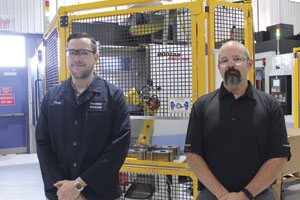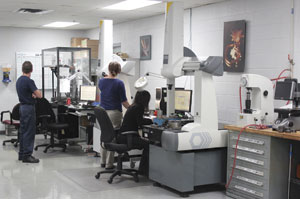by Andrew Brooks
Precision Resource lives up to its name with automated laser measuring
THE PROBLEM: An error-prone manual tool measurement process
THE SOLUTION: An automated laser system built for tough conditions
Even in an age when automation is touted as the key to industrial efficiency, quality and competitiveness, manual processes still have a place. No amount of automation can replace the judgement and experience of a veteran engineer or machine operator. And the handshake will always seal a deal better than any conceivable digital back-and-forth.
The manual touch has its place, but for fineblanking specialist Precision Resource Inc., tool measurement was one process that had everything to gain by being automated.
Precision Resource was founded in the US in 1947 as Fairfield Tool Co. and now boasts facilities in Mexico and China, four in the US, and two in Canada. The company’s Cambridge, ON, facility contains some of the company’s most critical operations.
 Fineblanking, a hybrid metal forming process that combines metal stamping and cold forming, produces metal parts to near net shape with a high degree of accuracy. A high proportion of Precision Resource’s customer base is in the automotive sector, but the company also works in the heavy duty truck, offroad and farm equipment, medical, defence and industrial equipment industries.
Fineblanking, a hybrid metal forming process that combines metal stamping and cold forming, produces metal parts to near net shape with a high degree of accuracy. A high proportion of Precision Resource’s customer base is in the automotive sector, but the company also works in the heavy duty truck, offroad and farm equipment, medical, defence and industrial equipment industries.
Precision Resource’s triple-action presses, combined with specially designed tooling, produce parts impossible to make with any other stamping process. There are more than 100 fineblanking presses in operation across the company’s global operations–a total Precision Resource says puts it in the global lead. Presses range in size from 40 to 1400 tons, which is the greatest range in the industry, the company says.
Precision Resource also boasts an extensive array of secondary capabilities, including CNC machining, grinding, insert moulding and a number of sub-assembly processes.
Cambridge, ON is also home to Precision Resource’s technical centre. Here the focus is on design support, prototype production, secondary process development, limited production, and the building of fineblanking tools, one objective being to expand in-house capabilities and reduce the need for secondary operations (see sidebar).
For secondary machining, Precision Resource operates a number of CNC machining centres, including a six-machine cell running Doosan VC 430 VMC mills. These are equipped with auto pallet changers so while one pallet is being machined, the table rotates to bring a second pallet into the ready position. Precision Resource has also added robotic loaders to the machines to speed things up.
Until recently, however, tool measurement remained manual, generating delays and conflict. The standard procedure was familiar: set the tool in the holder, set it on a block and touch it with a digital height gauge to get the distance from the bottom of the tool holder to the top of the tool. The operator would write the figure on a tag, attach the tag to the tool and place the tool in the tool rack. When another operator needed the tool he’d put it into the machine and manually enter the number on the tag to register the offset.
That approach simply amplified human error, says manufacturing engineer Brant Kardas. “We had several crashes either from the numbers being typed in or written down wrong, or the writing being illegible. That’s when you get claims and counterclaims. You get finger pointing.”
The blame game didn’t do anything to correct the basic problem. And a solution was imperative when you consider that erroneous figures even led to tools cutting right through the work piece into the fixture itself. When that happened, a machine could be down for days waiting for a new component.
Precision Resource decided it was time to invest in an automated laser tool measuring system. When Kardas looked at a few contenders, it emerged that the rough conditions inside the machining centres was a sticking point for some systems.
“A couple of other companies had something similar to what we ultimately bought,” he recalls. “But they said they wouldn’t recommend putting a laser system inside the machine at all because of all the coolant that’s moving around in there. They recommended using a plunger system instead.”
A plunger system requires the tool to make contact with the plunger in order for the measurement to take place. Since the machines used at Precision Resource each have two fixtures, two plungers would be required for each machine.
 “There are a lot of issues with that, based on the fixtures themselves,” Kardas says. “And there’s also added time. The tool has to come all the way down and push on the plunger.” The laser system checks the tool almost right out at the spindle as soon as the tool changes, reducing travel time and cycle time. It can also check diameter and run out with the push of a button, whereas a plunger system only measures for length.
“There are a lot of issues with that, based on the fixtures themselves,” Kardas says. “And there’s also added time. The tool has to come all the way down and push on the plunger.” The laser system checks the tool almost right out at the spindle as soon as the tool changes, reducing travel time and cycle time. It can also check diameter and run out with the push of a button, whereas a plunger system only measures for length.
The concern other laser manufacturers expressed about the rugged conditions turned out to be a decisive factor in favour of Blum-Novotest’s Mini-Micro-Nano laser system. “Blum simply told us that a rugged environment was what their lasers were built for,” Kardas says. “They’re made to run in conditions where coolant is dripping off the spindle.” An air jet on the front of the laser keeps coolant away from the lens, which is also equipped with a shutter that opens during measurement but otherwise remains closed.
As part of the purchase package, Blum handled the installation of the laser tool measuring system on the Doosan machines, finishing the work in May 2016. With the lasers in place, the procedure is now simpler, faster and, of course, much more highly automated. “The operator loads the tool into the spindle and hits cycle start. We have all the data in the program so when you do a tool change, the laser turns on, measures the diameter, the length, and the run out on the tool,” Kardas says. For drills, the run out is critical, especially with reamers; if the spin isn’t straight, the hole will wind up oversized. “With the lasers in place we don’t have to hold anyone accountable other than for putting the tools in the holders correctly,” Kardas says. “This system automatically puts the input right into the machine. No more operators pressing buttons based on what they thought they read off a tag. It’s improved efficiency. The change is dramatic.” SMT
